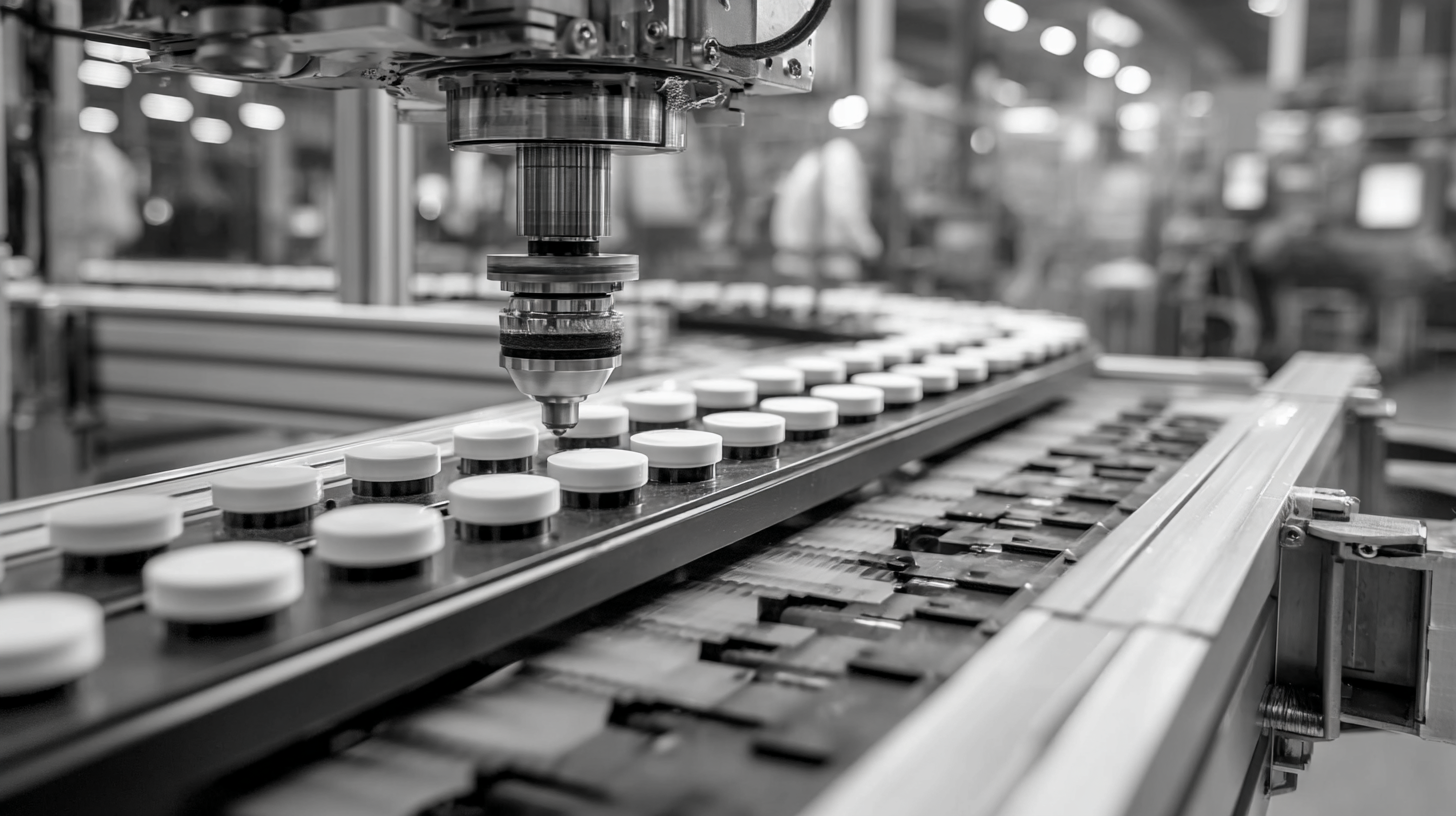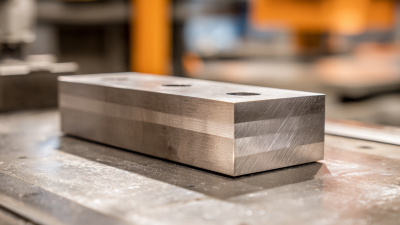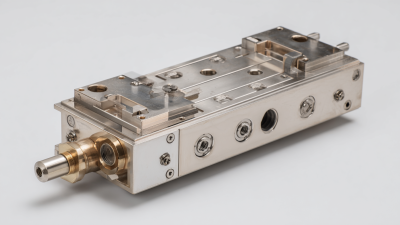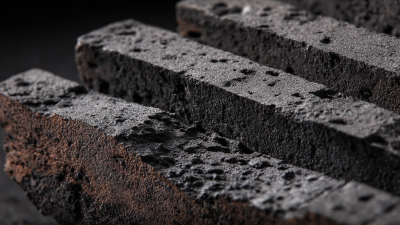The Future of ESD Ceramic Paddle Innovations and Their Impact on Global Supply Chains
Table of Contents
- Emerging Trends in ESD Ceramic Paddle Technologies: An Overview of Recent Innovations
- The Role of ESD Ceramic Paddles in Enhancing Supply Chain Resilience and Efficiency
- Impact of ESD Ceramic Paddle Innovations on Global Semiconductor Manufacturing Processes
- Market Analysis: Growth Projections for ESD Ceramic Paddle Demand by 2025
- Sustainability Considerations in ESD Ceramic Paddle Production and Use
- Challenges and Solutions in Scaling Up ESD Ceramic Paddle Manufacturing for Global Markets
- FAQS
- Conclusion
- Related Posts
The increasing demand for high-performance electronic devices and components has propelled innovations in various sectors, particularly in the production of ESD ceramic paddles, which play a critical role in semiconductor manufacturing and packaging. As reported by industry analysts, the global market for ESD protection devices is projected to reach $3.2 billion by 2025, highlighting the urgent need for advanced materials like precision ceramics.

St.Cera Co., Ltd., a leading player in this market, specializes in the research, development, and manufacturing of precision ceramic parts. With a team of top-ranking experts and engineers, St.Cera is at the forefront of ESD ceramic paddle innovations, paving the way for enhanced performance, reliability, and sustainability in global supply chains. This blog will explore the future of ESD ceramic paddle innovations and their profound impact on industry dynamics and supply chain efficiency.
Emerging Trends in ESD Ceramic Paddle Technologies: An Overview of Recent Innovations
The emergence of advanced ESD (Electrostatic Discharge) ceramic paddles is reshaping the landscape of manufacturing and logistics, with innovative trends increasingly influencing global supply chains. Recent developments in materials science have led to the creation of lighter, more durable ceramics that effectively mitigate the risks associated with electrostatic discharge. These innovations not only enhance the safety and reliability of electronic components during transport but also contribute to a more efficient production process.
When incorporating ESD ceramic paddles into your operations, consider the benefits of their integration with smart technologies. By utilizing paddles that are equipped with RFID tags, companies can track inventory more effectively and reduce the risks of damage during handling. This tech-forward approach ensures that products remain protected against static electricity while streamlining logistics for better overall productivity.
As industries continue to evolve, adopting these cutting-edge technologies can significantly improve supply chain resilience. Companies must stay informed about the latest trends in ESD ceramic paddle innovations to maintain a competitive edge. Investing in research and development will be crucial for organizations looking to optimize performance and expand their market presence while leveraging the benefits of advanced ESD solutions.
The Future of ESD Ceramic Paddle Innovations and Their Impact on Global Supply Chains
| Innovation Area | Description | Impact on Supply Chain | Emerging Trend | Adoption Rates (%) |
|---|---|---|---|---|
| Advanced Material Development | Research into new composites that improve static dissipation | Reduces occurrences of product failures | Shift towards smarter materials | 35% |
| Automation in Manufacturing | Increased use of automated processes for paddle production | Enhances efficiency and reduces labor costs | Integration of AI in production | 60% |
| Sustainability Features | Development of eco-friendly materials and processes | Improves corporate responsibility perceptions | Focus on reducing carbon footprint | 45% |
| Customization Technologies | Enhanced methods for personalized ESD ceramic paddles | Increases customer satisfaction and reduces waste | Demand for tailored solutions | 25% |
| Smart Technology Integration | Embedding sensors and IoT capabilities in paddles | Enhances data collection and monitoring | Move towards Industry 4.0 | 50% |
The Role of ESD Ceramic Paddles in Enhancing Supply Chain Resilience and Efficiency
As global supply chains become increasingly complex and interconnected, enhancing resilience and efficiency is paramount. ESD (Electrostatic Discharge) ceramic paddles play a critical role in this evolution. These specialized tools provide not just protection against static electricity but also improve material handling processes, ensuring that sensitive components remain intact throughout the supply chain. By integrating ESD ceramic paddles into logistics systems, manufacturers can minimize downtime caused by product damage, ultimately leading to smoother operations.
Moreover, the innovation in ESD ceramic paddle technology significantly boosts supply chain efficiency. These paddles are designed to withstand high temperatures and abrasive conditions, making them suitable for various environments, from semiconductor manufacturing to automotive assembly lines. Their durability translates to fewer replacements and maintenance needs, allowing businesses to allocate resources more effectively. As companies strive for just-in-time manufacturing and quick turnarounds, the incorporation of advanced ESD ceramic paddles not only supports operational goals but also strengthens supply chains against potential disruptions, ensuring a more reliable delivery of goods in a fast-paced market.
Impact of ESD Ceramic Paddle Innovations on Global Semiconductor Manufacturing Processes
The global semiconductor manufacturing landscape is on the brink of transformation, largely due to innovations in ESD (Electrostatic Discharge) ceramic paddle technology. These advancements not only enhance the precision and reliability of semiconductor processes but also influence the entire global supply chain associated with semiconductor production. Companies like ST.CERA CO., LTD. are at the forefront of this shift, harnessing their expertise in precision ceramic manufacturing to develop cutting-edge solutions that meet the evolving needs of the market.
As ESD ceramic paddles improve, they ensure that sensitive components are protected from electrostatic discharges during handling and processing. This enhancement leads to increased yield rates and reduced losses, ultimately benefiting manufacturers and consumers alike. Tip: Investing in advanced ESD ceramic technologies can significantly mitigate risks in production lines, enhancing overall operational efficiency.
Moreover, the adoption of these innovations is reshaping logistics and inventory management within the semiconductor sector. The ability to produce more reliable components ensures consistency throughout the supply chain, making it easier to forecast demand and manage resources effectively. Tip: Companies should prioritize partnerships with experts in precision ceramic manufacturing to stay ahead in a competitive market and improve their supply chain resilience.
Market Analysis: Growth Projections for ESD Ceramic Paddle Demand by 2025
The demand for ESD ceramic paddles is poised for significant growth in the coming years, driven by advancements in precision ceramic manufacturing and increased applications across various industries. With a projected growth rate closely aligning with other specialized markets, such as the badminton shoe market, which is expected to reach USD 8.34 billion by 2034, the ESD ceramic paddle sector offers valuable opportunities for manufacturers and suppliers alike. This surge in demand underscores the importance of innovative materials that can enhance product performance, meeting the needs of high-tech electronic applications.

Furthermore, the evolving landscape of global supply chains will feel the impact of these innovations. As companies like ST.CERA CO., LTD. leverage their expertise in precision ceramic manufacturing, the ability to produce high-quality ESD ceramic paddles will streamline supply chains and ensure the availability of critical components. By focusing on research and development, the market is set to experience transformations that not only enhance product offerings but also improve production efficiencies. As the industry anticipates these changes, stakeholders must remain adaptable to harness the full potential of ESD ceramic paddle innovations by 2025.
Sustainability Considerations in ESD Ceramic Paddle Production and Use
As industries increasingly turn to sustainable practices, the production and use of ESD (Electrostatic Discharge) ceramic paddles are undergoing significant transformation. Recent reports indicate that the global market for sustainable materials in electronics is projected to reach $72 billion by 2027, driven by a growing demand for eco-friendly components. This shift highlights the necessity for manufacturers to consider the environmental impact of ESD ceramic paddle production, particularly in terms of raw material sourcing and energy consumption.
ESD ceramic paddles traditionally rely on materials that may contribute to environmental degradation; however, advancements in sustainable manufacturing processes are paving the way for greener alternatives. According to a study by the International Association of Electronics Recycling, adopting circular economy principles could reduce waste by up to 50%, underscoring the importance of reusing and recycling materials in paddle production. By integrating sustainable practices, companies can not only enhance their brand reputation but also align with regulatory requirements aimed at reducing carbon footprints and minimizing ecological impacts.
Challenges and Solutions in Scaling Up ESD Ceramic Paddle Manufacturing for Global Markets
The challenges of scaling up ESD ceramic paddle manufacturing for global markets are multifaceted, particularly as the aerospace and defense sectors embrace a broader array of technological innovations. According to recent industry reports, operational efficiencies can be enhanced by leveraging advanced materials and process automation, which are critical for meeting the escalating demand for high-performance components. For instance, small to mid-sized producers are increasingly recognized as pivotal players in this transition, highlighting the necessity to adopt scalable manufacturing techniques that balance quality with rapid output.

Addressing these scalability challenges requires an integrated approach that combines strategic supply chain management with cutting-edge production technologies. The rise of automated systems, as demonstrated by advancements in fully automated production lines in the pharmaceutical sector, showcases significant possibilities for reducing lead times and optimizing resource usage. Additionally, as market dynamics shift towards globalization, manufacturers must prioritize flexibility and adaptability in their production systems to respond swiftly to varying demands. Investing in innovative solutions, like generative AI tools, can further streamline operations and drive efficiencies across the supply chain, ensuring that ESD ceramic paddles remain competitive in emerging global markets.
FAQS
: ESD ceramic paddles are tools used to protect sensitive semiconductor components from electrostatic discharges during handling and processing. They are crucial for enhancing the precision and reliability of semiconductor manufacturing processes.
Innovations in ESD ceramic technology lead to increased yield rates and reduced losses by effectively protecting sensitive components, ultimately benefiting both manufacturers and consumers.
Advanced ESD ceramic technologies significantly mitigate risks in production lines, which enhances overall operational efficiency and reduces potential disruptions.
The adoption of ESD ceramic paddles improves the reliability of components, ensuring consistency throughout the supply chain, which facilitates better demand forecasting and resource management.
The global market for sustainable materials in electronics is projected to reach $72 billion by 2027, driven by an increasing demand for eco-friendly components.
Manufacturers are increasingly adopting sustainable manufacturing processes and sourcing greener raw materials to minimize environmental impacts, thereby aligning with eco-friendly initiatives.
Adopting circular economy principles could reduce waste in ESD ceramic paddle production by up to 50%, highlighting the importance of reusing and recycling materials.
Collaborating with experts in precision ceramic manufacturing allows companies to stay competitive in the market and improve their supply chain resilience through the use of advanced technologies.
Integrating sustainable practices can enhance brand reputation, align with regulatory requirements, and help minimize carbon footprints and ecological impacts.
Manufacturers should consider raw material sourcing, energy consumption, and the adoption of sustainable practices in the production of ESD ceramic paddles to reduce environmental degradation.
Conclusion
The blog titled "The Future of ESD Ceramic Paddle Innovations and Their Impact on Global Supply Chains" explores the latest advancements in ESD ceramic paddle technologies and their vital role in enhancing the efficiency and resilience of supply chains. With a focus on the semiconductor manufacturing sector, it highlights how innovations in ESD ceramic paddles can streamline processes, ultimately contributing to smoother operations and reduced downtime.
Furthermore, the blog addresses market growth projections for ESD ceramic paddle demand by 2025, emphasizing the importance of sustainability in both production and use. It also delves into the challenges faced in scaling up manufacturing for global markets, offering insights into potential solutions. With St.Cera Co., Ltd. at the forefront of precision ceramic manufacturing, the company is positioned to lead in this evolving landscape, capitalizing on emerging trends that will shape the future of the industry.
Related Posts
-

The Future of Innovative Ceramic Cylinder Solutions for Global Trade
-

Innovative Applications of Aluminum Nitride Plates in Modern Technology
-

Ultimate Guide to Sourcing the Best Sic Wafer Arm for Your Manufacturing Needs
-

How to Choose the Best ESD Wafer Arm for Optimal Semiconductor Processing Efficiency
-

How to Choose the Best Sapphire Tube: Essential Metrics and Industry Insights for Global Buyers
-

How to Choose the Best Silicon Carbide Plates for Your Industrial Needs
Blog Tags:

